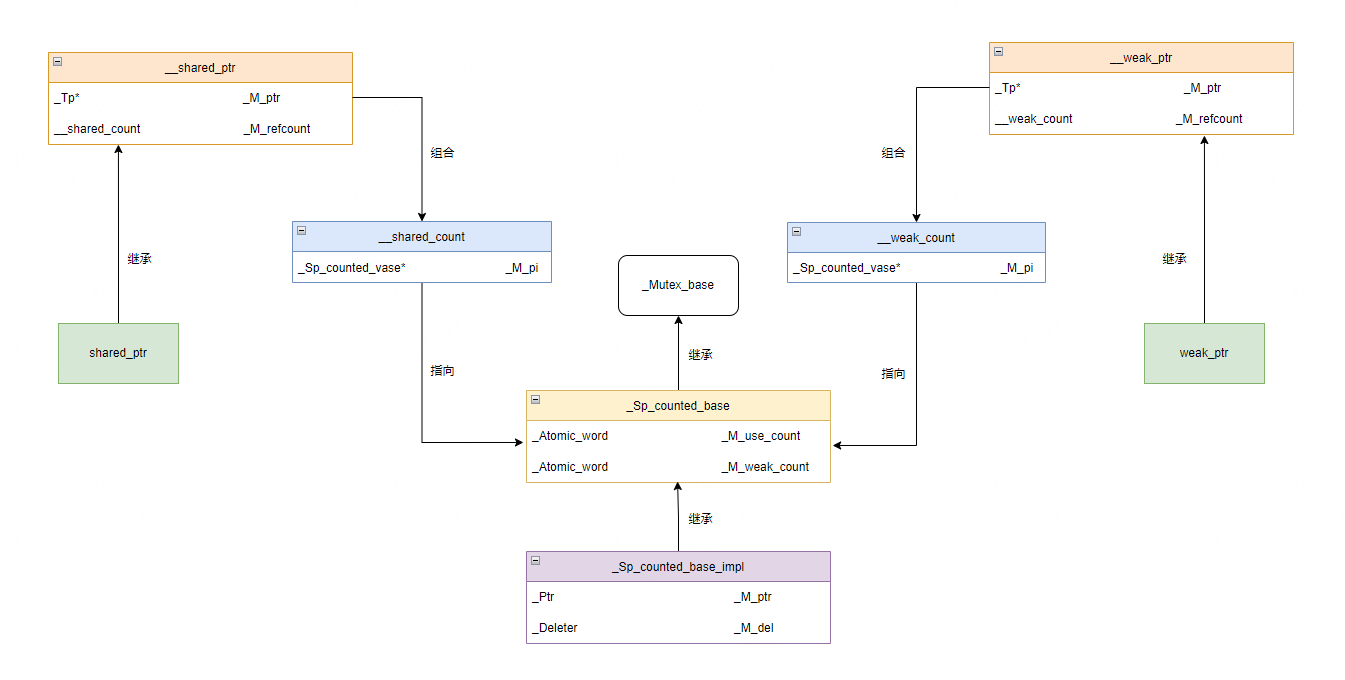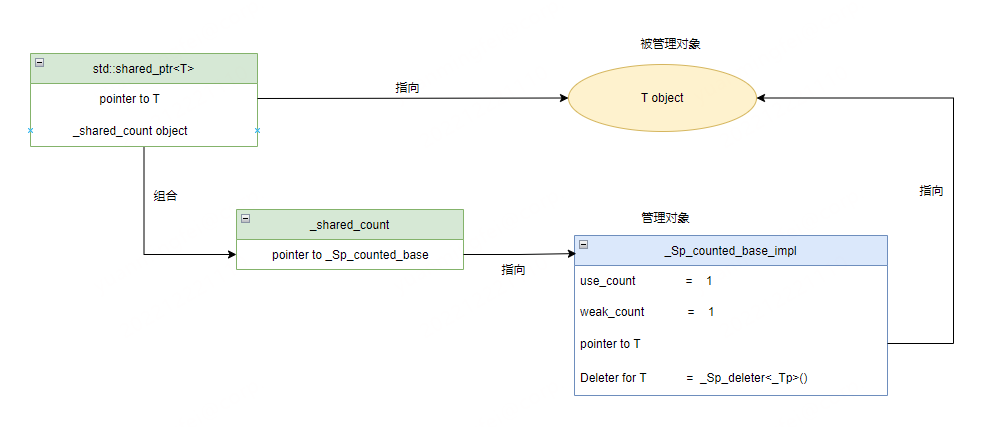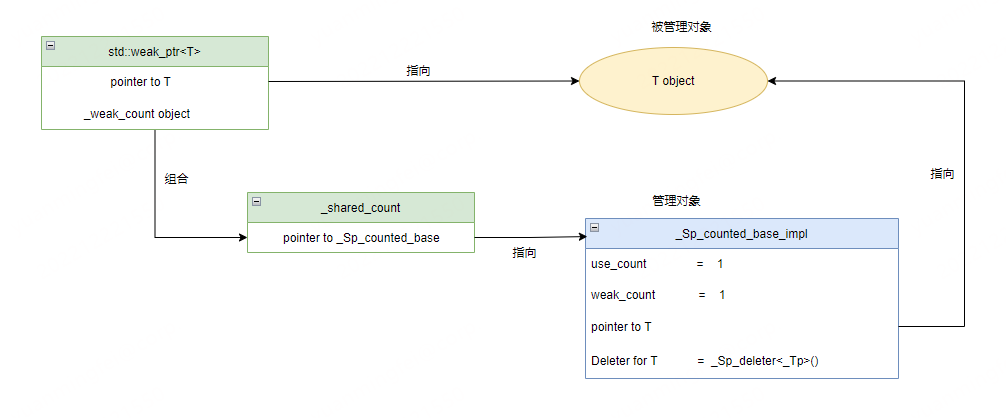1.RAII思想 RAII是C++内存管理的一种思想,资源获取视为初始化。使用对象封装资源的获取与释放操作,对象初始化时调用构造函数完成资源获取,对象离开作用域自动调用析构函数完成资源释放,避免了忘记调用销毁函数的情况,降低内存泄漏风险。如下例子:
1 2 3 4 5 6 7 8 9 10 11 template <typename T>class MyLock {public :explicit MyLock (T& mutex) :_mutex(mutex) { lock (); MyLock () {unlock ();
这段代码可以保证初始化的时候加锁,生命周期结束后自动释放锁,同时天生异常安全,因为C++异常栈展开时会调用局部对象的析构函数。
2.智能指针 2.1 基本介绍 智能指针就是采用RAII思想实现的资源管理模板类,由标准库提供,需要包含<memory>头文件。
名字
管理方式
特点
std::unique_ptr
独享
某一时刻只能有一个对象占有资源;
std::shared_ptr
共享
支持多个对象共享资源;联用
2.2 基本用法 2.2.1 unique_ptr 初始化
1 2 3 4 5 6 7 8 9 10 11 12 13 14 15 16 17 18 19 20 21 22 23 24 25 26 27 28 29 30 31 32 33 34 35 36 37 struct Foo {Foo () { std::cout << "Foo\n" ; }Foo () { std::cout << "~Foo\n" ; }std::unique_ptr<Foo> p1 (std::make_unique<Foo>()) ;std::unique_ptr<Foo> p2 (new Foo()) ;std::unique_ptr<int []> parr (new int [10 ]) ;struct D {D () {};D (const D&) { std::cout << "D copy ctor\n" ; }D (D&) { std::cout << "D non-const copy ctor\n" ;}D (D&&) { std::cout << "D move ctor \n" ; }void operator () (Foo* p) const "D is deleting a Foo\n" ;delete p;std::unique_ptr<Foo, D> p3 (std::make_unique<Foo>(), D()) ; std::unique_ptr<Foo, D> p4 (std::make_unique<Foo>(), d) ; auto deleter = [](int * ptr) {"[deleter called.]" << std::endl;delete ptr;std::unique_ptr<int , decltype (deleter) > p5 (new int , deleter) ;
手动释放
1 2 3 4 5 6 7 8 9 10 11 12 13 14 std::unique_ptr<Foo> p1 (std::make_unique<Foo>()) ;auto p = p1.release ();reset (new Foo ());reset (nullptr );std::unique_ptr<Foo> up1 (new Foo(1 )) ;std::unique_ptr<Foo> up2 (new Foo(2 )) ;swap (up2)
2.2.2 shared_ptr 初始化
1 2 3 4 5 6 7 8 9 10 11 12 13 14 15 16 struct Foo {Foo () { std::cout << "Foo\n" ; }Foo () { std::cout << "~Foo\n" ; }std::shared_ptr<Foo> p1 (std::make_shared<Foo>()) ;std::shared_ptr<Foo> p2 (new Foo()) ;std::shared_ptr<Foo> p3 (new Foo, [](auto p) { std::cout << "Call delete from lambda...\n" ; delete p; })
手动释放
1 2 3 4 5 6 7 8 reset (new Foo ());reset (nullptr );reset (p2);
2.3 shared源码分析 1 源码来自:/usr/i nclude/c++/ 9 /tr1/ shared_ptr.h,对无关内容做了适当删减
2.3.1 类整体结构 shared_ptr为资源管理对象,内部维护对应的资源指针。shared_ptr对象销毁时会根据递减内部的引用计数来决定是否真正销毁资源,同时支持多个对象共同享有同一份资源,只需要改变引用计数即可。整体类图如下:
2.3.2 shared_ptr分析 a> 初始化过程 __shared_ptr的构造函数如下:
1 2 3 4 5 6 7 8 9 10 11 12 13 14 15 16 17 18 19 20 21 22 23 24 25 26 27 28 29 30 31 32 33 template <typename _Tp, _Lock_policy _Lp>class __shared_ptr public :typedef _Tp element_type;0 ), _M_refcount() template <typename _Tp1>explicit typedef int _IsComplete[sizeof (_Tp1)];template <typename _Tp1, typename _Deleter>private :
从源码可以得到shared_ptr指针初始化会将参数指针(来自new运算符或者是make_shared得到)初始化给_M_ptr成员,再用参数指针去初始化__shared_count<_Lp>类,该类的构造函数如下:
1 2 3 4 5 6 7 8 9 10 11 12 13 14 15 16 17 18 19 20 21 22 23 24 25 26 27 28 29 30 31 32 33 34 35 36 37 38 39 40 41 42 43 template <_Lock_policy _Lp = __default_lock_policy>class __shared_countpublic : 0 ) template <typename _Ptr>0 )typedef typename std::tr1::remove_pointer<_Ptr>::type _Tp;new _Sp_counted_base_impl<_Ptr, _Sp_deleter<_Tp>, _Lp>(delete __p;template <typename _Ptr, typename _Deleter>0 )new _Sp_counted_base_impl<_Ptr, _Deleter, _Lp>(__p, __d);private :friend class __weak_count <_Lp>;
可以看见在__shared_count<_Lp>类的构造函数中调用new运算符申请了一个_Sp_counted_base_impl<_Ptr, _Sp_deleter<_Tp>, _Lp>对象,该类的构造函数如下:
1 2 3 4 5 6 7 8 9 10 11 template <typename _Ptr, typename _Deleter, _Lock_policy _Lp>class _Sp_counted_base_impl : public _Sp_counted_base<_Lp>public :private :
该类public继承自_Sp_counted_base类,并且默认构造父类,父类构造函数如下:
1 2 3 4 5 6 7 8 9 10 template <_Lock_policy _Lp = __default_lock_policy>class _Sp_counted_base: public _Mutex_base<_Lp>public : 1 ), _M_weak_count(1 ) { }private :
可以看见将_M_use_count和_M_weak_count成员默认初始化为1,表示当前只被引用了一次,此时shared_ptr整体类布局如下:
b> 销毁过程 __shared_ptr类不存在析构函数,直接看其组合类_shared_count的析构函数,代码如下:
1 2 3 4 5 6 7 8 9 10 11 12 13 14 15 16 17 18 19 20 21 22 23 24 25 26 27 28 29 30 31 template <_Lock_policy _Lp = __default_lock_policy>class __shared_countpublic : template <typename _Ptr>0 )typedef typename std::tr1::remove_pointer<_Ptr>::type _Tp;new _Sp_counted_base_impl<_Ptr, _Sp_deleter<_Tp>, _Lp>(delete __p;if (_M_pi != 0 )private :friend class __weak_count <_Lp>;
析构函数中调用_Sp_counted_base_impl类的_M_release()函数,但是这个函数是在父类_Sp_counted_base_中实现的非纯虚函数,代码如下:
1 2 3 4 5 6 7 8 9 10 11 12 13 14 15 16 17 18 19 20 21 22 23 24 25 26 27 28 29 30 31 32 33 34 template <_Lock_policy _Lp = __default_lock_policy>class _Sp_counted_base: public _Mutex_base<_Lp>public : 1 ), _M_weak_count(1 ) { }void _M_release() if (__gnu_cxx::__exchange_and_add_dispatch(&_M_use_count, -1 ) == 1 )if (_Mutex_base<_Lp>::_S_need_barriers)if (__gnu_cxx::__exchange_and_add_dispatch(&_M_weak_count, -1 ) == 1 )virtual void _M_destroy() delete this ; }private :
M_release()函数中首先对_M_use_count进行减1操作,如果减1之前为1,调用子类_Sp_counted_base_impl的_M_dispose()函数,再对_M_weak_count进行减1操作,同样判断减1前是否为1,如果是,调用父类_Sp_counted_base的_M_destroy()函数。代码如下:
1 2 3 4 5 6 7 8 9 10 11 12 13 14 15 16 17 18 19 20 21 22 23 24 25 26 27 28 29 30 template <typename _Ptr, typename _Deleter, _Lock_policy _Lp>class _Sp_counted_base_impl : public _Sp_counted_base<_Lp>public :virtual void _M_dispose() private :template <_Lock_policy _Lp = __default_lock_policy>class _Sp_counted_base: public _Mutex_base<_Lp>public :1 ), _M_weak_count(1 ) { }virtual void _M_destroy() delete this ; }private :
可以看见,_M_dispose()中调用_M_del销毁器销毁被管理的资源对象,_M_destroy()中调用free销毁资源管理对象,可以得出结论:
_M_use_count计数器控制被管理资源对象的声明周期
_M_weak_count计数器控制资源管理对象的声明周期
c> 拷贝过程分析 __shared_ptr的拷贝控制成员如下:
1 2 3 4 5 6 7 8 9 10 11 12 13 14 15 16 17 18 19 20 21 22 23 24 25 26 27 28 29 30 template <typename _Tp, _Lock_policy _Lp>class __shared_ptr public :template <typename _Tp1>const __shared_ptr<_Tp1, _Lp>& __r)template <typename _Tp1>explicit __shared_ptr(const __weak_ptr<_Tp1, _Lp>& __r)template <typename _Tp1>operator =(const __shared_ptr<_Tp1, _Lp>& __r) return *this ;private :
可以看见支持使用shared_ptr和weak_ptr进行拷贝,后者是在weak_ptr中调用lock()函数时调用的。
初始化列表_M_refcount(__r._M_refcount)都调用了__shared_count<_Lp>类的拷贝构造函数进行拷贝;
代码如下:
1 2 3 4 5 6 7 8 9 10 11 12 13 14 15 16 17 18 19 20 21 22 23 24 25 26 27 28 29 30 31 32 33 34 35 36 37 38 39 40 41 42 43 44 45 46 47 48 49 50 51 52 53 54 55 56 57 58 59 60 61 62 template <_Lock_policy _Lp = __default_lock_policy>class __shared_countpublic : const __shared_count& __r)if (_M_pi != 0 )explicit const __weak_count<_Lp>& __r) if (_M_pi != 0 )else operator =(const __shared_count& __r) if (__tmp != _M_pi)if (__tmp != 0 )if (_M_pi != 0 )return *this ;private :friend class __weak_count <_Lp>;
可以看见先是对资源管理指针进行值拷贝,这里也就说明了当多个shared_ptr指向同一块资源时,他们之间只有一份共享资源管理对象;
如果是用shared_ptr进行拷贝,将use_count引用计数加1。
如果是用weak_ptr进行拷贝,此时就是weak_ptr调用lock()时,也会将use_count引用计数加1,并且会判断加之前是否为0,如果是则抛出异常。
d> reset函数实现 关键代码如下:
1 2 3 4 5 6 7 8 9 10 11 12 13 14 15 16 17 18 19 20 21 void reset () swap (*this ); }void swap (__shared_ptr<_Tp, _Lp>& __other) swap (_M_ptr, __other._M_ptr);template <typename _Tp1>void reset (_Tp1* __p) 0 || __p != _M_ptr); swap (*this );template <typename _Tp1, typename _Deleter>void reset (_Tp1* __p, _Deleter __d) swap (*this ); }
这里的实现很巧妙,根据参数不同原地构造不同的局部对象,使用swap交换指针所指向的内容,交换后新构造出来的对象变为要销毁的对象,在函数结束时自动调用析构函数完成销毁,充分体现了RAII思想。
2.3.3 weak_ptr分析 a> 初始化过程 __weak_ptr的构造函数如下:
1 2 3 4 5 6 7 8 9 10 11 12 13 template <typename _Tp, _Lock_policy _Lp>class __weak_ptr public :typedef _Tp element_type;0 ), _M_refcount() private :
weak_ptr只能默认初始化,过程很简单,weak_count中的无参构造函数如下:
1 2 3 4 5 6 7 8 9 10 11 12 template <_Lock_policy _Lp>class __weak_count public :0 ) private :friend class __weak_count <_Lp>;
可以看见将指针赋值为0,基本上什么也没做,其实这种用法不常见,最常见的还是绑定到shared_ptr指针上,也就是调用拷贝构造函数。
b> 拷贝过程分析 __weak_ptr的拷贝控制成员如下:
1 2 3 4 5 6 7 8 9 10 11 12 13 14 15 16 17 18 19 20 21 22 23 24 25 26 27 28 29 30 31 32 33 34 35 36 37 38 39 40 template <typename _Tp, _Lock_policy _Lp>class __weak_ptr public :typedef _Tp element_type;template <typename _Tp1>const __weak_ptr<_Tp1, _Lp>& __r)lock ().get ();template <typename _Tp1>const __shared_ptr<_Tp1, _Lp>& __r)template <typename _Tp1>operator =(const __weak_ptr<_Tp1, _Lp>& __r) lock ().get ();return *this ;template <typename _Tp1>operator =(const __shared_ptr<_Tp1, _Lp>& __r) return *this ;private :
可以看见可以使用使用shared_ptr和weak_ptr两种指针进行拷贝初始化和拷贝赋值。
这里只讨论使用shared_ptr初始化weak_ptr,会调用__weak_count<_Lp>类的shared版本的拷贝构造函数,如下:
1 2 3 4 5 6 7 8 9 10 11 const __shared_count<_Lp>& __r)if (_M_pi != 0 )
可以看见会将资源管理对象的指针直接给weak_count,再将_M_weak_count引用计数加1。可以得到结论:weak_ptr绑定shared_ptr不会影响资源引用计数,weak_ptr和shared_ptr共用一份资源管理对象。weak_ptr与shared_ptr内部结构类似,如图所示:
c> 销毁过程分析 _weak_count析构函数如下:
1 2 3 4 5 6 if (_M_pi != 0 )
_Sp_counted_base类中的_M_weak_release()代码如下:
1 2 3 4 5 6 7 8 9 10 11 12 13 14 15 16 17 18 19 20 21 _M_weak_release() if (__gnu_cxx::__exchange_and_add_dispatch(&_M_weak_count, -1 ) == 1 )if (_Mutex_base<_Lp>::_S_need_barriers)
可以看见weak_ptr的销毁过程只递减了_M_weak_count引用计数,并判断决定是否销毁资源管理对象。
d> lock函数实现 代码如下:
1 2 3 4 5 6 7 8 9 10 11 12 13 14 15 16 17 18 __shared_ptr<_Tp, _Lp> lock () const #ifdef __GTHREADS if (expired ())return __shared_ptr<element_type, _Lp>();return __shared_ptr<element_type, _Lp>(*this );const bad_weak_ptr&)return __shared_ptr<element_type, _Lp>();
原理就是调用shared_ptr可以接受weak_ptr版本的拷贝构造函数来初始化一个shared_ptr返回,并且会造成_M_use_count引用计数加1。
2.4 shared指针问题 2.4.1 循环引用 a> 错误示例 1 2 3 4 5 6 7 8 9 10 11 12 13 14 15 16 17 18 19 struct C {int main () auto parent = std::make_shared <C>();auto child = std::make_shared <C>();reset (); reset ();return 0 ;
上面代码parent和child指针都不会被释放,在释放parent时,存在child指向,释放child时,存在parent指向。
b> 解决办法 将结构C其中一个shared_ptr改为weak_ptr
1 2 3 4 5 6 7 8 9 10 11 12 13 14 15 16 17 18 19 struct C {int main () auto parent = std::make_shared <C>();auto child = std::make_shared <C>();reset (); reset (); return 0 ;
2.4.2 this问题 shared_ptr能够安全管理资源的一个前提是,多个共享资源的shared_ptr所使用的资源管理对象是同一个。如果不是同一个,在销毁时会对同一份资源进行double free。
a> 错误示例 1 2 3 4 5 6 7 8 9 10 11 12 13 14 15 16 17 18 19 20 class Thing {public :void modify () std::shared_ptr<Thing> p2 (this ) ;int main () "begin" << std::endl;std::shared_ptr<Thing> p1 (new Thing) ;modify ();"end" << std::endl;return 0 ;
运行结果如下:
代码会出现双重释放错误,在资源内部使用资源自身this初始化shared_ptr会在shared_ptr的构造函数中使用new重新申请一个资源管理对象。此时两个不同的资源管理对象同时管理一份资源,所以会造成对同一资源的二次释放错误。
b> 解决办法 C++引入了enable_shared_from_this类来解决这个问题,关键代码如下:
1 2 3 4 5 6 7 8 9 10 11 12 13 14 15 16 17 18 19 20 21 22 23 24 25 26 27 28 29 30 31 template <typename _Tp>class enable_shared_from_this protected :enable_shared_from_this () { }enable_shared_from_this (const enable_shared_from_this&) { }operator =(const enable_shared_from_this&)return *this ; enable_shared_from_this () { }public :shared_ptr<_Tp> shared_from_this () { return shared_ptr <_Tp>(this ->_M_weak_this); }shared_ptr<const _Tp> shared_from_this () const { return shared_ptr <const _Tp>(this ->_M_weak_this); }private :template <typename _Tp1>void _M_weak_assign(_Tp1* __p, const __shared_count<>& __n) const template <typename _Tp1>friend void __enable_shared_from_this_helper(const __shared_count<>& __pn,const enable_shared_from_this* __pe,const _Tp1* __px)if (__pe != 0 )const_cast <_Tp1*>(__px), __pn);mutable weak_ptr<_Tp> _M_weak_this;
只需要让出现问题的Thing类继承自enable_shared_from_this即可在内部维护一个weak_ptr,需要使用指针时,只需要调用shared_from_this()成员即可。修改后的代码如下:
1 2 3 4 5 6 7 8 9 10 11 12 13 14 15 16 17 18 19 20 21 class Thing public std::enable_shared_from_this<Thing> {public :void modify () std::shared_ptr<Thing> p2 (shared_from_this()) ;int main () "begin" << std::endl;std::shared_ptr<Thing> p1 (new Thing) ;modify ();"end" << std::endl;return 0 ;



